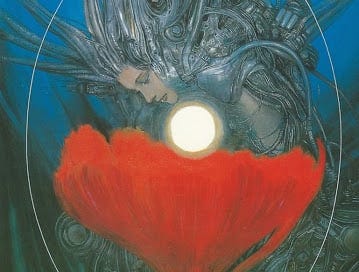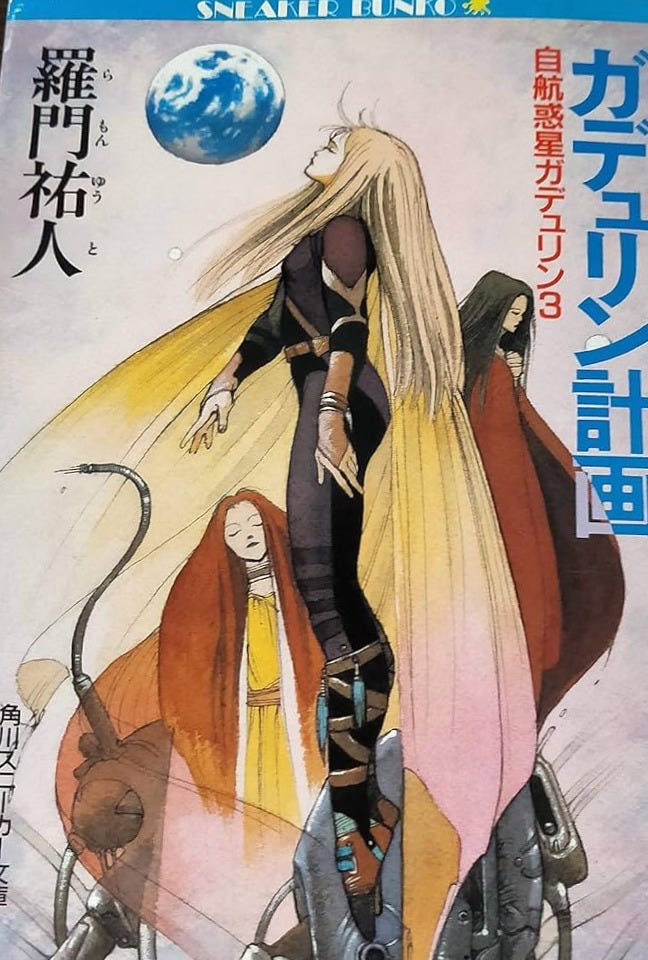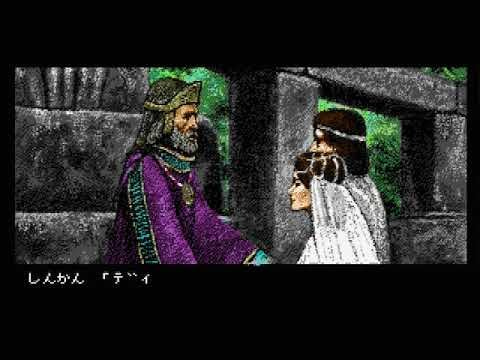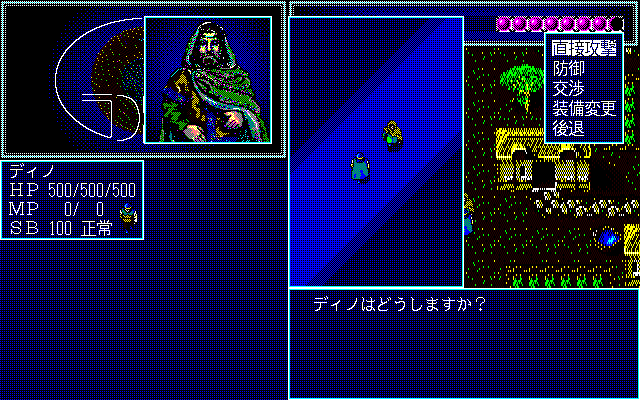Developer: Artec
Publisher: Apros, Artec
Director: Yuuto Ramon
Scenario writer: Yuuto Ramon
Soundtrack: Yoh Ohyama (OST), Hitoshi Sakimoto (chipset for the PC88 version)
Genre: Turn based RPG
Progression: Non linear, with a huge emphasis on sandbox exploration and simulative elements, including day and night cycles, jobs, food, illnesses and others
Country: Japan
Platform: NEC PC88, MSX2, NEC PC98
Release Date: 1988 (PC88, Japan)
Status: Researched from the mid ‘10s to 2021
Science-fantasy has been a core part of JRPG settings since the genre’s first decades, with series such as Phantasy Star, Cosmic Fantasy, Star Ocean and others mixing fantasy worlds with overt or hidden sci-fi elements in a number of different ways. While some developers have veered on archetypes more in line with hard sci-fi narrative, like with Koei’s Progenitor, Infinite Space or the Cyber Knight and Xenosaga series, albeit with some caveats, other titles have found a sort of compromise in using artificial settings with fantasy twists, like Ar nosurge’s colony ship, or man-made worlds like Phantasy Star 3’s Alisa III or the mostly forgotten Gdleen.
The self-propelled world of Gdleen, sometimes romanized as Gadulin, was a mysterious, gigantic colony spaceship inhabited by different alien races created in 1988 as the backdrop of a light novel sci-fantasy series written by Yuto Ramon (the pen name of Yuhei Yamaguchi) and illustrated by Hitoshi Yoneda, better known as the Yonesan who worked on some of Sega’s Phantasy Star's character design and covers. The series, composed by a trilogy and a sequel tetralogy, was later adapted first as an OVA, and then as a videogame on Super Famicom, unsurprisingly titled Gdleen, whose main claim to fame comes from being the very first original JRPG released on that platform back in March 1991.
Before that, though, Gdleen's world had already been visited in videogame form some years before on Japanese home PCs (1988 on NEC's PC88, 1989 on MSX and 1990 on PC98, even if I've found conflicting information on the last two dates), with another, lesser known title, Digan no Maseki. This early attempt to adapt Gdleen was developed by Artec, a company actually founded by Gdleen author Yuto Ramon himself. Ramon had been working in the nascent Japanese videogame industry since some years before, being one of the founders of Random House alongside his friend Kazurou Morita back in 1983, only to split up in order to create his own company three years later. Before Digan no Maseki, he had actually already developed a JRPG, Minelvaton Saga, which will later become a full fledged franchise when its setting would be revisited in Silva Saga and its sequel on Super Famicom, where Ramon choose to be credited with his real name, Yamaguchi.
Compared to what Gdleen on Super Famicom will try later, Digan no Maseki seems to be a much more liberal adaptation that, going with what I was able to piece together from a variety of Japanese sources, was based on the series' setting and on material taken from the third novel, Gdleen Project, while both the OVA and the Super Famicom JRPG seem to be mostly centered on the events of the first volume, Kamigami no Mikotachi, following the light novels' original protagonist and his adventures.
Now, Artec-developed Digan no Maseki is such a surprising title one really doesn't know where to start, so maybe we could follow the game's own example and begin our journey with the marriage of two humble villagers, Dino and Abilia, who, after sealing their union in the village of Cartea, go on an honeymoon of sorts by performing a ritual pilgrimage to the Fountain of Vision in Euradona.
The vision they end up seeing is that of an ominous statue-construct of a goddess, offering words of wisdom that, in our newlyweds' case, turn out to be all but reassuring: if they split up immediately they will live good, easy lives, but, if they decide to stay together, they will be struck by misfortune and will have to overcome a number of trials if they want to achieve an happy life together. Undaunted, the two return together to their own Cartea, only to find out how true the prophecy was when Abilia is struck by a mysterious illness that starts to traumatically alter her body into a bio-mechanical creature, forcing Dino to journey into the continent of West Fern, and the wider world of Gdleen, to find a cure.
Digan no Maseki could very well be considered one of the most experimental JRPGs released during the late '80s purely by virtue of its systems and the way they interact with each other, showing an early mix between proto-JRPG mechanics and some WRPG sensibilities, acting in some ways as a precursor to non-linear JRPGs like part of the SaGa franchise, Soul & Sword, Traverse, Zill O'll and others, though it doesn't look as influenced by tabletop RPGs as, say, the Super Famicom Sword World titles, which were a direct adaptation of a Japanese tabletop RPG system, or the Lunatic Dawn series.
As it happens, Dino's journey is very free form and has lots of simulation elements, with the player needing to take care of food, sleep, wounds (that can temporarily reduce your maximum HP) and illnesses, apparently including STDs if Dino isn't able to keep true to his nuptial vows. The player is also able to select different topics while talking to NPCs (possibly even choosing to fight them on occasion, a feature that's extremely uncommon in JRPGs aside from outliers like Radita Stories, Soul Nomad and the Octopath Traveler series), making Dino work actual jobs in order to raise money like an early Ryo Hazuki, needing a magic ring to communicate with other races and being able to recruit a variety of NPCs and to explore most of the world from the get go.
Since I mentioned SaGa, Digan no Maseki's character growth seems to be fairly similar to Final Fantasy 2 and many SaGa games in linking stat growth to actions taken in battle rather than level ups, a design trait that will later become one of Akitoshi Kawazu’s signature traits in terms of game design. Dino is apparently the only character the player can fully control, with the recruitable allies having various degrees of autonomous actions depending on their loyalty.

Digan no Maseki also features a day and night cycle, with each day divided into eight turns, a turn into 8 runs, and a run into 16 merlans, meaning a day consists of 1024 merlans. Each step taken in game makes 1 merlan pass, but holding the 5 key also lets time pass without Dino moving a single step, a bit like what happens in roguelikes while continuing to wait or defend in order to let enemies expose themselves or accelerate auto-healing. Aside from determining Dino's tiredness (as I said before, he needs to sleep to avoid lowering his SB-sanity stat, which is also influenced by drinking alcoholics), this cycle also determines which NPCs you end up meeting, with criminals and brigands unsurprisingly being more common at night, introducing an early grind strategy to farm some money before fully tackling Dino's journey.
Unlike in some WRPGs like the old Ultima titles or, more recently, Warhorse’s Kingdom Come: Deliverance, food is consumed automatically, while the aforementioned illnesses have an interesting twist that doesn't really sound particularly enticing in the days of COVID-19, since some of them are also trasmissible to fellow party members, meaning Dino catching a cold could actually end up damaging the stats of the whole party. No wonder that Digan no Maseki also features what could be the one and only antipyretic spell in JRPGs, Reduce Fever.
The game's presentation, with a top-down view mixed with somewhat realistically proportioned sprites that is kept even during the game's instanced combat, is more in line with early WRPGs such as the Ultima series (Ultima 5 released just a year before Digan no Maseki) rather than early JRPGs imitating the first person, turn based battles found in Wizardry or Dragon Quest titles. The game also follows a rather popular trend of that period, especially on home PC JRPGs, by having the exploration shown in windowed mode, with the party's core stats always visible on the left and NPC portraits appearing on the top left part of the screen.
There are also quite a number of artworks depicting the game's main events, and that takes us to Digan no Maseki's most obvious peculiarity: being the only JRPG, alongside the bizarre shmup-action JRPG hybrid Guardic Gaiden, to sport an art direction by the legendary Naoyuki Kato, and one of the very few on home PC in that period (alongside Enix's Reichsritter, Kure Software's Early Kingdom, Gust's Ares Monogatari and Falcom's Dinosaur) to have a fairly realistic character design.
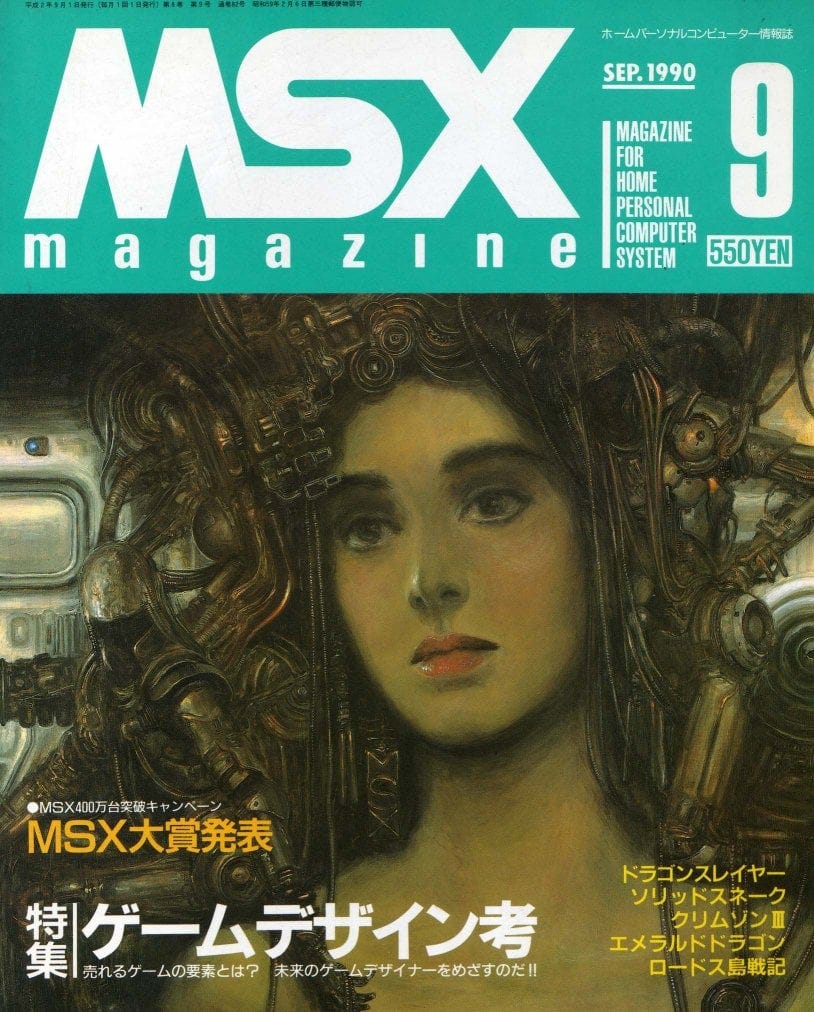
Compared to many other works done by Kato, Digan no Maseki shows an higher degree of variety, with his usual eerie Giger-esque and sci-fi bio-mechanical transhumanism mixed with grounded fantasy depiction of villagers in traditional costumes, natural (and less than natural) hazards and Gdleen's own non-human natives, which end up bringing his work in a sci-fantasy direction he later explored in Omiya Soft’s Culdcept franchise, which heavily featured his work. Given we're talking about a late ‘80s JRPG released on home PC, it’s also interesting to notice Digan no Maseki doesn't seem to have any overt adult contents aside from some partial nudity, which has likely to do with its literary source material.
Kato's uniquely unsettling, transhumanist art style also betrays Digan no Maseki's sci-fi vein and its setting’s true nature since the game's very cover, a bit like what will happen decades later with Russian novel Hard to be a God’s RPG adaptation: while back in the late ‘80s the Japanese audience would have been able to easily make that connection just by noticing it was based on the Gdleen series, thus knowning the world explored by Dino was actually a gigantic spaceship, apparently that came as a plot twist for the protagonist himself, and one could excuse him considering Digan no Maseki was actually the first RPG set on a colonial-generational spaceship, well before the abovementioned Sega's Phantasy Star 3, Gust's Ar nosurge or Western RPG Colony Ship, by the Age of Decadence developers. Digan no Maseki’s final stretch apparently dealt with the mysterious Gdleen Project, a key plot point both for the light novel series and for Dino and Abilia's own destiny.

There's yet another reason Digan no Maseki is such an interesting title, though I admit it's much more subjective: one of the reasons I became interested in the world of Gdleen's JRPG adaptations and started researching them, in fact, was because of its soundtrack which was composed by one of my favorite niche Japanese composers, Yoh Ohyama, mostly known for his outstanding work on many Nitroplus visual novels and JRPGs, like the Cladun franchise, not to mention a little known Atelier spin-off, the Idea Factory-developed otome visual novel Atelier Elkrone. Despite being one of his earliest works, though, Digan no Maseki’s soundtrack is also one of his highlights, partially thanks to the arrangement made by a veritable industry legend, Basiscape founder Hitoshi Sakimoto, that in 1989 had yet to achieve fame and actually wanted to pursue a career as a programmer rather than a composer.
Sakimoto also worked on the Terpsichorean synth sound driver used in the PC88 version, which also explains why that version of Digan no Maseki's soundtrack is so noticeably superior compared to its other versions, the rather disappointing MSX2 and PC98 ports, despite those being released well after the PC88 original. Interestingly, this also was Sakimoto's first contract work, according to an interview released in 2016, which explains why one of his next works was working on the soundtrack for Super Famicom’s Gdleen, well before he made a name for himself as Yasumi Matsuno’s favorite composer for titles such as Ogre Battle, Tactics Ogre, Final Fantasy Tactics, Vagrant Story, Final Fantasy XII and Crimson Shroud, not to mention plenty of others like Vanillaware’s lineup and the Valkyria Chronicles franchise.

Digan no Maseki unfortunately ended up as a mostly forgotten footnote in home PC and early JRPG history, so far also lacking any meaningful fantranslation effort, which unfortunately is mostly the case for the entirety of the Japanese home PC RPG lineup, a veritable mine of hidden gems that are still waiting for someone technically savvy enough to make them shine outside Japan.
After its release, Yuto Ramon and Artec reused some of its sandbox, simulative design traits in other home PC RPGs like Dark Wraith and Witches of Barbatos, which are possibly even less known and documented than Digan no Maseki itself, later opting for simpler and more linear systems. In fact, after developing the first Silva Saga on Famicom alongside Seta, Artec itself was soon closed down by Yuto Ramon when he choose to go freelance, with the rest of the staff joining Rits alongside Hiroshi Kajiyama to work for Sega on the Shining Force handheld Gaiden line, later repurposed as Shining Force CD for Mega CD, and Moldorian on Game Gear.
Even then, the tale of Gdleen’s attempts to break into the JRPG space is far from over, and the second part of this piece will focus on the abovementioned homonym Super Famicom game, which ended up following a completely different path in its attempt to adapt its source material to the videogame format, possibly also due to the influence of Gdleen’s own OVA adaptation.
Note: I wrote a previous version of this piece about Digan no Maseki and Gdleen back in April 2021, on the r/JRPG subreddit. Thanks to PasokonDeacon for helping me with some much-needed info about Artec, at a time when they weren’t as easily available as they’re now.

